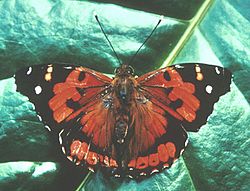Ditrysia facts for kids
The Ditrysia are a very large and important group of insects. They belong to the Lepidoptera order, which includes all the butterflies and moths. In fact, about 98% of all known butterfly and moth species are part of the Ditrysia group!
This group is special because of a unique feature in how they reproduce. The name "Ditrysia" actually means "two openings." This refers to the female moths and butterflies having two separate openings: one for mating and another for laying eggs. This is different from some older groups of moths that only have one opening for both.
Quick facts for kids Ditrysia |
|
|---|---|
 |
|
| The Kamehameha butterfly is a type of Ditrysia. | |
| Scientific classification | |
| Kingdom: | |
| Phylum: | |
| Class: | |
| Order: | |
| Suborder: |
Glossata
|
| Infraorder: |
Heteroneura
|
| (unranked): |
Ditrysia
|
| Principal groups | |
|
Ditrysia Borner, 1925
*Hesperioidea (skippers) *Papilionoidea (true butterflies) |
|
Contents
What Makes Ditrysia Special?
The main thing that makes Ditrysia unique is how their bodies are set up for reproduction. Female Ditrysia have two distinct openings. One is for mating, and the other is for laying eggs. This is a big evolutionary step that helped them become so successful.
This special design allows them to mate and lay eggs more efficiently. It's one of the reasons why Ditrysia are so diverse. They have adapted to many different environments around the world.
Types of Ditrysia
The Ditrysia group is incredibly diverse. It includes tiny "micromoths" and also the much larger and more familiar moths and all butterflies.
Micromoths
Some of the Ditrysia are called "micromoths." These are generally smaller moths. They often have simpler wing patterns. Many of them are considered more "basal," meaning they are closer to the early ancestors of the group.
Apoditrysia: Larger Moths and Butterflies
The Apoditrysia is a major subgroup within Ditrysia. This group includes most of the larger moths you might see. It also contains all the butterflies. Butterflies are actually a specialized type of moth that evolved to be active during the day.
Some well-known groups within Apoditrysia include:
- Macrolepidoptera: This means "large Lepidoptera." It includes many of the big, colorful moths. Examples are the giant silkworm moths and the fast-flying hawk moths.
- Rhopalocera: This is the scientific name for all butterflies. This group includes the beautiful swallowtails, painted ladies, and many other familiar butterflies.
Importance in Nature
Ditrysia play many important roles in nature.
- Pollination: Many moths and butterflies visit flowers to drink nectar. As they do this, they carry pollen from one flower to another. This helps plants reproduce.
- Food Source: The caterpillars of Ditrysia are a major food source for many animals. Birds, bats, and other insects eat them. Adult moths and butterflies are also eaten by predators.
- Decomposers: Some moth caterpillars help break down dead plant material. This returns nutrients to the soil.
Understanding Ditrysia helps scientists learn more about insect evolution. It also helps us protect these important creatures.
See also
 In Spanish: Ditrysia para niños
In Spanish: Ditrysia para niños

